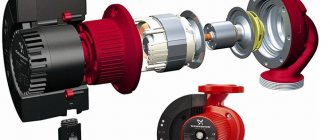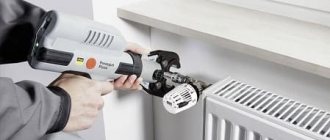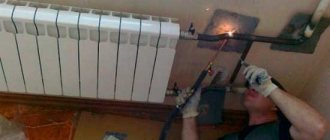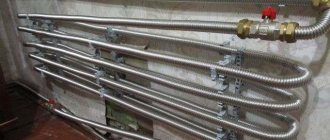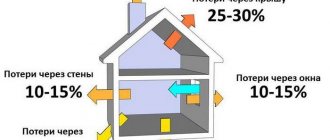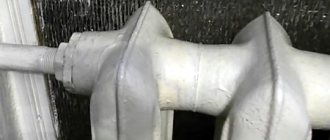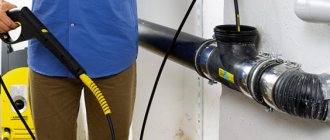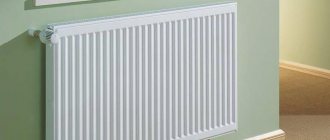Comfortable heating operation is only possible if a high-quality radiator is installed. Replacing batteries on a gas welding machine allows you to be confident in the strength, reliability and durability of the connection. In order to properly prepare and carry out this work, you need to understand the features of using gas welding when replacing heating equipment.
Gas welding equipment for radiator replacement Source portaltepla.ru
Why do they sometimes need to be changed?
During the cold season, comfort in the house depends on the quality of the radiators. If the temperature at home is too low, additional measures must be taken to correct the situation. 25 degrees is considered the most comfortable. Sometimes the cause of problems is heating radiators.
The following reasons may be grounds for replacement:
- Worn and unreliable previously installed radiator.
- Low power of the device used.
- Uneconomical energy consumption for heating.
- Significant structural damage accumulated over a long period of time.
- Carrying out major repairs during which it is possible to update the heating system.
Of course, in most cases it is possible to refuse repairs and leave everything as it is. However, in this case, residents will have to use ineffective heating, which will not be able to warm up the apartment.
A specialist performs the work Source portaltepla.ru
How to install a radiator using gas welding:
Types of welds and joints
Depending on the relative position of the pipes, they are connected:
- end-to-end, when the ends are adjacent to each other;
- in a T-bar, if the pipes are arranged in the shape of the letter T;
- at an angle when it is necessary to change direction by 45 or 90˚;
- overlap by flaring the end of one pipe and putting it on the other.
Depending on the possibility of access to the joint, the connection is made:
- With a horizontal seam, if a vertical section of the pipeline is being installed.
- Vertical when the pipeline is in a horizontal position.
- Ceiling when the joint is welded from below. Such a seam has to be applied during repair of the heating system when replacing the damaged area.
- Pipes are welded bottom when installing new systems, when it is possible to rotate them so that the electrode is on top of the joint.
Carrying out repairs
If the homeowner realizes the need to replace the radiators, then he will have to do it himself or invite a professional to do the work. In the latter case, you will need to take the following steps:
- You need to choose a suitable specialist and ensure his arrival. He will study the situation on the spot, take the necessary measurements and draw up a work plan. You can get recommendations from your specialist on choosing suitable radiators for replacement.
- To understand what radiators and pipes are needed, and to choose the right equipment, it is important to understand how the heating system works, the advantages and disadvantages of various designs. Using existing knowledge and expert advice, the necessary equipment is purchased.
- Before replacing heating batteries with gas welding, it is necessary to ensure the dismantling of the existing structure. It is best to do this shortly before installing new equipment. Before work, you need to shut off the water supply. In a situation where repairs are being carried out in an apartment building, you will need to contact the Housing Office for this.
- The technician determines the exact location and begins installation. Next comes the replacement of equipment and installation of welding radiators.
- When the replacement is completed, it is necessary to test the reliability of the equipment. To do this, you need to turn on the water supply. The tenant or master does not have the right to do this on their own. To check the quality of the work done, you need to contact a housing office employee.
The efficiency of the updated heating system will be determined not only by the quality of the specialist’s work, but also by the correct choice of pipes and radiators.
Certificate required to work as a welder Source portaltepla.ru
The main stages of installing heating batteries using electric welding
To begin with, it must be said that the installation of heating radiators using gas welding must be performed by a qualified welder with many years of experience and appropriate education.
Also, it is imperative to use high-quality equipment that meets modern safety requirements, allowing you to obtain a weld of increased strength and reliability.
The sequence of work is no less important, because each stage has its own characteristics, to which considerable attention should be paid. Among the main steps of work that involve replacing heating radiators with gas welding, we can highlight:
Among the main steps of work that involve replacing heating radiators with gas welding, we can highlight:
- Draining water from the heating system is necessary so that there are no problems when dismantling old batteries and installing new ones. As a rule, in a private house there will be no problems with removing water from the system, because a special tap is provided for this.
- Removal of old heating radiators. As a rule, the instructions are quite simple - using the most ordinary grinder, the pipes are cut. This is done in such a way that subsequent installation of new batteries can be done quickly and easily.
- Packing a new radiator. This procedure can be done with your own hands and involves the use of certain materials, in particular, flax, investment paste, an adjustable wrench and a set of nuts (the same type as the pipes in the system). The process is carried out in this way: first, screw the nuts onto the pipes protruding from the radiator (sealed with flax and coated with investment paste), then install the American and Mayevsky tap on the side where the pipes will be joined.
- Radiator installation. Heating radiators are installed in full accordance with the personal wishes of the home owner (usually in place of an old radiator) - the photo below can be used as an example. The radiator is connected by screwing the tap into the pipe, connecting it to the American one and then adjusting the heating pipe for welding to the riser. Afterwards, the process of welding with a gas apparatus is carried out directly, the installation of a jumper and (if desired) a tap on it is carried out - this will ensure additional circulation of the coolant not only through the battery.
Dismantling the heating system
Requirements for the welder and equipment
Today, for many people who decide to replace heating radiators in their home, the main factor in choosing a welding specialist is price.
But, as a rule, this criterion is incorrect, because unskilled craftsmen often work at low prices and will not ensure the required welding quality, reliability and tightness of the system.
Truly qualified craftsmen involved in gas welding of heating radiators and other plumbing fixtures must have:
- Fire safety permit (valid) and a welder’s certificate confirming the specialist’s qualification level.
- Modern equipment for performing gas welding work. It is best if the welder works with devices that allow the production of metal compounds in an oxygen-acetylene environment. The use of filler wire is also mandatory.
- Positive feedback on the work performed (best with videos of objects).
Only if the welder is truly a specialist in his field, the heating system with the installation of new batteries will begin to work more efficiently and productively.
Gas welder's kit
Depreciation of equipment
The use of metal options is in most cases reliable and convenient, but it also has important disadvantages. If you do not change the heating equipment. Over time, the inside of the pipes gradually becomes overgrown, reducing the diameter and making it difficult for the coolant to pass through.
This happens because the water contains impurities that settle on the walls. This process proceeds very slowly, but over many years it will lead to a decrease in the flow of coolant and a deterioration in the quality of heating.
The coolant circulates in the heating system under high pressure. Over many years of operation, it can significantly deform the threaded joints. When using gas welding, this problem does not exist.
The deposits inside pipes and radiators are hard and almost impossible to clean. If they are located in the radiator, then due to its complex shape it is difficult to access them. The only way to fix the heating is to replace pipes and radiators.
The use of taps is mandatory Source 1-teplodom.ru
How to obtain work permits?
Only professional gas welders who have a document confirming their education in this specialty are allowed to install heating batteries using gas welding. In addition, the welder must have a valid fire safety permit. It is advisable that the specialist has experience (excellent, if many years) in carrying out gas welding work. The quality of the final result is also affected by the equipment used, which must not only be in good working order, but also meet established safety requirements.
Gas welding work is carried out in special clothing, in special glasses with a protective shield that prevents the eyes from catching “bunnies,” as experienced welders say. We must not forget about gloves that protect the skin of the hands from the effects of negative factors.
Mandatory equipment for a gas welder includes protective equipment such as goggles, a shield, and work gloves. All listed items are intended for gas welding work.
Please note that at the moment in apartment buildings there is a ban on carrying out gas welding work without obtaining permission from the authorized bodies. Violators of this legal norm face a significant fine.
How to legally change the heating in an apartment
Replacement of radiators in an apartment must be carried out with the consent of the management company. To do this, you need to write an application to the chief engineer of the management company, requesting consideration of the possibility of replacing the radiator for certain reasons.
If the management company agrees, you will have to order a heating system reconstruction project from an organization that has SRO approval. Next, the chief engineer of the management company approves the project or sends it to an interdepartmental commission. After the MEC, the chief engineer takes over again. Next, to replace the pipe, you hire an organization with SRO approval (even if your relative is a certified welder, he will be able to replace the radiator in the apartment only if he has a welder’s certificate and a fire safety permit). Copies of all documents are kept in the management company.
Welder's certificate
If refused, you can go to court or insist that the management company fulfill its duties, including replacing the heating system in an apartment building.
This is interesting: Which pipes to choose for heating: which options are better and why?
How to connect radiators
The main element of the heating system that affects the quality of heating is the radiator. During operation, a large amount of coolant passes through it. It is important to ensure a reliable connection to the pipes.
Typically, a threaded connection made using gas welding is used for this. The second is absolutely reliable and can completely eliminate the possibility of leakage throughout the entire service life.
When carrying out the work yourself, you need to select the dimensions of the new radiator so that it fits in the place intended for it. Welding requires the availability of appropriate equipment and skills to work with it. Connecting the radiator is carried out in several steps:
- Before starting the procedure, you need to remove the furniture located in the work area. Nearby sections of walls and floors are covered with non-combustible material.
- Before starting work, you must call a specialist from the housing office or management company to turn off the water while the equipment is being replaced. If we are talking about a private house, then the owner can do this work himself by opening the drain tap.
- Old radiators are being removed. It is often done using a grinder. At the same time, you need to monitor the quality of the cut to which the new equipment will be attached.
- Before joining parts, it is necessary to clean the surfaces. The parts that are joined must fit each other exactly.
- Before welding, the radiator is installed on special mounts in the place where it will be located in the future.
- Carrying out welding work. At the same time, the connected areas are heated. At the same time, the filler wire is supplied. Its material should best suit the metal from which the pipes and radiator are made. An acetylene torch is most often used. You can use methane or propane, but you need to monitor the flame temperature. It should be twice that which is sufficient to melt the filler wire.
- After the procedure is completed, you must wait for the parts to cool completely. Then a thorough inspection of the connections is carried out. There may be some areas that will need to be re-processed. In order to ensure complete sealing, the connection must be reliable.
- At the last stage, the reference seams are cleaned. To do this, you need to wait until the surface cools down. After this, the parts are painted.
After installation of new equipment, high-quality heating will be provided.
Using gas welding you can get a beautiful connection Source tsaritsyno.online
Dangers when carrying out welding work in an apartment
Any type of welding work involves high temperatures. The electric welding electrode and the gas welding torch have a temperature of several thousand degrees Celsius. In addition, welded or cut metals of pipes and metal structures of the apartment are heated to almost the same temperatures.
As a result, any contact of flammable objects, things, substances with welding can lead to a fire.
In addition, heated metal has the ability to spread during welding and even drip onto the floor and onto the walls. As a result, when welding work in a residential area, burnout of the finishing materials of the floor and walls, as well as burnout of furniture, is possible.
Gas welding cylinders are especially dangerous. Their improper storage does NOT lead to a fire, but to an explosion.
One more danger that should not be forgotten when carrying out welding work in an apartment is the neighbors. As I already mentioned, drops of molten metal from welding can fall into neighbors' apartments. For example, when carrying out welding work on a balcony. Or carrying out work in the bathroom to replace water pipes or install a welded bypass.
How to strip and paint
When gas welding of radiators is carried out, scorch marks and stains remain on the metal. If left like this, it will look unattractive. Therefore, it is important to clean and repaint the equipment. To do this, perform the following steps:
- First, the surface is treated with sandpaper. For this, N 3 or N 4 is usually used.
- If there are deposits, it is not recommended to remove them with a grinder. If you do this, the strength of the connection will decrease.
- Remove dust from connections using a damp cloth. After this, it is recommended to additionally wipe the connection with dry material.
- The surface is degreased using a solvent.
- Cover the metal with two layers of anti-corrosion primer.
- Heat-resistant enamel is applied. It is advisable to use several layers. This must be done so that the blackness does not show through the paint. Each subsequent layer is applied after the previous one has completely dried.
Work is carried out when the equipment is cold. In this case, the paint durability will be higher. If there is a need to carry out work in winter, the heating must be turned off in advance, providing the opportunity to cool down. The color of the enamel is chosen so that it matches the design of the surrounding environment.
Two radiators in one room Source tsaritsyno.online
How to replace a radiator using welding:
Features of gas welding technology
The fastening of heating pipes by gas welding is carried out according to the following principle: the end parts of the two elements are combined, and then gradually heated in the gas-oxygen mixture to high temperatures.
It is best to replace radiators in the warm season, since during the cold season you will have to turn off the general heating of the house for at least several hours, which is unlikely to please the neighbors
For special weld strength, filler material in the form of wire or rod is used. When the hot metal cools, a monolithic joint is formed.
Advantages and disadvantages of joining pipes by welding
One of the main reasons for the popularity of the gas welding method is the specific operation of our heating systems.
When the coolant circulates, all structural elements are constantly under pressure, which deforms the joints. Therefore, a strong weld seam reliably protects against breakthroughs and helps prevent accidents during short pressure surges and even water hammer, which often accompany the startup and shutdown of centralized heating.
If gas welding is done efficiently, the pipes will have a smooth surface without sharp transitions or visible sagging, and black marks from the flame will be perfectly masked by paint
Advantages of the gas welding method:
- Durability and reliability of the connection (it is believed that the strength of the seams after gas welding even exceeds the strength of the radiators themselves!).
- Possibility of using parts of any shape and size. The only requirement is that the elements be made of metal with a thickness of no more than 3.5 mm (if this is exceeded, it is more economical to use electric arc welding).
- An aesthetic point - pipes and batteries, welded by gas welding, become a solid monolith, which can be easily repainted in a color that matches the interior.
- You can carry out work without connecting to the electrical network (especially important for a new building).
- Many metals from which pipes are made, such as copper, cast iron, brass and lead, form the strongest joints using gas welding.
The main disadvantage of this installation method is the large heating area, as a result of which it is easy to damage furniture and flammable finishing materials, such as parquet, wallpaper, plastic wall panels, chipboard or MDF. To avoid destruction, it is recommended to remove thermally unstable elements from the work area, and cover immobile elements with asbestos sheeting or other protective material.
If replacing batteries using gas welding is carried out after finishing finishing work, be sure to use insulating gaskets between the wall and the pipes
In addition, gas welding releases substances into the air that are harmful to health; working without special protective equipment is strictly prohibited. That is why everyone who wants to master a gas welding machine in practice must study the safety rules and obtain permission to work.
Who can operate a gas welding machine?
Installation of a heating system using gas welding is permitted only by professional welders who, in addition to special education, have permission to carry out work from the fire service. Please note that the document is issued only for a certain period, so when hiring a specialist, you should not just look at the “crust”, but also study its validity period
Other mandatory requirements for welders: the working order of the gas apparatus and mandatory protective equipment - goggles, work gloves, a shield.
It is advisable that the master use filler wire for seams and modern equipment operating on a mixture of oxygen and acetylene. Other flammable gases, such as methane or propane, are acceptable provided that their combustion temperature is twice the melting point of the filler rod.
A certificate of this type confirms that the specialist has the appropriate qualifications and has undergone safety training. A mandatory condition for authenticity is a seal
If you are not a professional gas welder, you can contact local heating networks or the organization that manages the house to carry out the work. To do this, the owner of the apartment draws up a statement about the need to replace the batteries and agrees on a date to shut off the flow of coolant in the common building main.
After welding and installation of radiators, the invited master must carry out commissioning work and make sure that the system is in good working order.
It is strictly prohibited to independently stop and start heating in apartment buildings. Date: September 25, 2022
Battery selection
The quality of heating depends not only on the installation, but also on the correct choice of radiator. It is important that it provides exactly the required amount of heat. If there is not enough of it, the residents will freeze. If there is a lot, there will be discomfort due to the heat, and energy for heating will also be wasted uneconomically.
When selecting equipment, you need to determine the most suitable material and take into account how many sections there should be in the radiator. It must be taken into account that the power of one is indicated in the technical documentation.
The simplest method of calculation is the following. It is necessary to take into account the area of the room. For a ceiling height of 2.40-2.65 m, the number of square meters must be multiplied by 100 W. The resulting value must be divided by the power of one section. This way you can determine their number.
The use of welding ensures a reliable connection Source tehkomfort.rf
A small radiator was suitable for this room Source tehkomfort.rf
The required value can be found in the documentation. If this is not possible, use the standard value of 170 W. If there is a need for rounding, this will need to be done upward.
In apartments with high ceilings, it is more advisable to use a different calculation method. Here you need to determine the volume of the room. To find out, it will be enough to multiply the area of the room by the height of the ceilings. The result obtained is multiplied by a coefficient corresponding to the type of building. For a panel one it is 41 W, for a brick one - 34. By dividing the calculated value by the heating power of one section, it will be possible to obtain their number.
The result will be approximate. For a more accurate accounting, you need to take into account the following:
- Features of the climate in the area where the housing is located.
- The presence of a balcony or loggia in the room.
- The number of windows available, as well as the method of glazing them.
- Number of floors, as well as the location of the apartment.
- The location of the radiator in the room and the use of a decorative screen for it.
- Use of external or internal insulation.
The most popular are radiators made of steel, aluminum, cast iron, copper, and bimetallic.
When carrying out work, you need to move the furniture to the side Source tsaritsyno.online
Preparing parts
Before starting pipe welding work, it is necessary to prepare the edges for the connection. I always do it in this order:
- I check the pipes for compliance with the parameters specified in the design of the engineering system (plumbing). The instructions require compliance with the following parameters:
- geometric dimensions;
- certificate of conformity (especially for pipes through which drinking water is supposed to be transported);
- absence of defects in the circumference (pipes must be perfectly round, not oval in cut);
- absence of defects in thickness (the walls of metal pipes must be the same along the entire length of the part);
- compliance of the chemical composition of the metal with the requirements set forth in GOST of Russia (this is determined during laboratory testing or from accompanying documents).
Cleaning the pipe end with a grinding machine before welding.
- I am preparing the pipes for connection. To do this, I personally recommend doing the following:
- check that the pipe edge is cut strictly at an angle of 90 degrees;
- clean the edge to a metallic shine (the width of the cleaned area should be up to 10 mm from the cut);
- degrease the end, remove all traces of oil, paint, rust, and so on.
For a correct connection, it is necessary that the opening angle of the pipe cut edges is about 65 degrees, and the blunting value is 2 mm. If this is not the case, additional machining of the end must be performed.
For this purpose, special chamfer removers, grinders and trimmers are used. Specialists who design large-diameter pipelines use milling machines or special preparation methods (plasma or gas cutters).
Tools for processing pipe ends will help any novice craftsman in his work.
What are the benefits of using gas welding?
Compared to using threaded connections, replacing heating radiators with gas welding is more profitable. The only important advantage of the former is the relative ease of disconnecting the old radiator and connecting a new one. When using gas welding you can get the following advantages:
- High level of reliability and durability of the connection. The place where the work took place is not inferior in strength to other sections of the pipe.
- Any required configuration can be connected.
- When replacing heating radiators on gas welding, you can adjust the heating temperature. This is done by changing the angle of exposure to the flame. In this way, the optimal operating mode is selected.
- Aesthetic appearance. Since this connection method does not use a large number of fittings. It will look more beautiful once the finishing touches are completed.
- Such work can be carried out without using an electrical network. This is important when replacing heating batteries with gas welding during repairs in new buildings or for connecting equipment outside the city.
- High protection from internal and external mechanical loads.
- Typically, in heating systems of apartment buildings, water is under high pressure. The use of rigid piping connected by welding is preferable in such conditions.
- The use of gas welding allows you to create reliable connections between parts made of various materials: steel, brass, copper and others.
- Water hammer may occur during operation. They have a destructive effect on threaded connections. Welded ones guarantee that in such cases there will be no leakage. When using other options, situations are possible when flooding occurs after a water hammer.
After replacing radiators with gas welding, you can be confident in the reliability and quality of the hydraulic system.
The video describes how to replace heating radiators:
Replacing batteries with gas welding guarantees high-quality seams!
The emergence of new proposals on the heating equipment market prompts the population to think about replacing old batteries with new heating radiators
In order to carry out the replacement, it is important to correctly determine how the heating radiators will be installed. There are many options by which the work can be done, but the most effective is to use gas welding
This is due to the fact that replacing batteries with gas welding has many advantages such as:
- Increased reliability. Provided that the work is completed by a highly qualified craftsman, the resulting seam will be reliable, thanks to which it can serve ideally for many years. In addition, the weld seam will not require additional attention, as is observed when performing installation using pre-mounted joints. This is due to the fact that the connection point does not have an additional seal, which, as a rule, is not durable in operation.
- Neat appearance. After the welding work is completely completed, the seam remains almost invisible, so it does not spoil the external design of the room and can remain in the open.
Only an experienced technician should be trusted to install heating radiators, since the efficiency and economy of the heating system will depend on the quality of the work performed. The craftsmen of our company are able to install radiators using gas welding efficiently and accurately.
| 1 | Replacement visit | PC | for free |
| 2 | Consultation and estimate | PC | for free |
| 3 | Purchase and delivery of materials | PC | for free |
| 4 | Replacement of batteries with gas welding from 20 pcs. | PC | 2500 |
| 5 | Replacement of batteries with gas welding from 10 pcs. | PC | 3000 |
| 6 | Replacing batteries with a gas welder from 4 pcs | PC | 3500 |
| 7 | Replacing batteries with a gas welder from 2 pcs | PC | 4000 |
| 5 | Replacing one battery with gas welding | PC | 5000 |
The advantage of replacing batteries with gas welding
Welding is a special process in which molten metal is poured between the edges of parts heated to a certain temperature.
It is important to note that the edges are heated to a temperature required by the technology and the characteristics of the material itself
Gas welding work is carried out to weld metal parts of various shapes; in addition, welding is used to eliminate defects from a metal surface, regardless of its shape and size.
Gas welding work to replace batteries consists of:
- preparatory part;
- welding (applying a seam);
- eliminating cracks and cavities from the surface of a metal part;
- smoothing seams (if necessary).
Only specially trained specialists are allowed to perform gas welding work, since only they are able to weld metal surfaces together as correctly and efficiently as possible.
How to replace heating batteries with gas welding
As already noted, with the help of gas welding it is possible to install heating radiators with the highest quality and reliability. The main explanation for this is that the metal edges of the pipe and radiator are connected by molten metal, which is formed as a result of melting the filler wire. Using gas welding, you can easily and most importantly quickly connect steel pipes to a radiator, the outer diameter of which does not exceed 100 millimeters. The fastening points (weld seam) are reliable and able to withstand high operating pressure in the system, which eliminates the possibility of a breakthrough. It should also be noted that the seam made by the master looks very neat compared to fittings and other available
A question that sooner or later faces almost every resident, be it an apartment in an apartment building or their own home in the private sector.
Among the variety of existing types of heating batteries and methods of their installation, it is difficult to make the right choice without special knowledge and experience in this area.
Therefore, whether the heating batteries will be replaced using gas welding or a threaded method, and what type of radiators to use, is best decided together with qualified specialists. If replacement and installation work is performed poorly, there is a high risk of costly property damage.
Disadvantages of using welding for heating installation
The use of gas welding is often very profitable, but it has certain disadvantages:
- Relatively large heating area during operation. If you do not take the necessary protective measures, nearby furniture, walls or ceilings may be damaged. To avoid such consequences, you need to remove flammable objects from the work site and cover the rest with protective material.
- When gas welding is carried out, harmful substances are released into the air. Therefore, it is necessary to use personal protective equipment at this time.
- To perform welding work, you must have the appropriate qualifications and obtain a work permit. If the welding is done by a professional, then he must have a permit.
The permit is given by the fire service and has a limited validity period. It is necessary to ensure that the welding machine is in good working order, and that personal protective equipment is used.
After welding, traces remain on the pipes Source tehkomfort.rf
Installation of a cast iron battery Source tehkomfort.rf
Pros and cons of the method when replacing radiators
Recently, heating radiators have been increasingly being replaced with gas welding. The primary reason for this is that the resulting welding joint in the installation area of devices with a pipe system is significantly stronger in strength than the joints joined to each other.
Advantages and disadvantages of installing steel pipes by welding:
- Protects the system from leaks and allows you to prevent an emergency situation in the event of significant surges in medium pressure from water hammer, which usually occur during startup/shutdown of main heating networks.
- High-quality welding work has a service life of at least the established period for the pipe system.
- Well applicable for old residential properties, in which the internal heating system is made of black rolled metal pipes.
- Connecting radiators is allowed for all existing piping schemes, including hidden pipe laying.
- When welding is used, the pipe flow area is not reduced, which has an extremely positive effect on the subsequent operation of the heating circuit.
- During the welding period, the metal of the elements being combined is melted and soldered at a high-quality molecular level. The result is the strongest plumbing connection.
- This type of connection is available for any type of heating device, including aluminum and bimetallic modifications.
- The different metals from which pipes are made, for example, copper, cast iron, brass and lead, create a very strong connection exclusively using gas welding.
- The method is applicable to parts of various shapes and sizes. The only requirement is that the parts be made of steel with a thickness of no more than 3.5 mm, otherwise it would be better to use electric arc welding.
- High aesthetic results of the work - the joints after gas welding form a solid monolith, which is easy to decorate in a color appropriate to the interior.
- It is possible to carry out work without electricity, which is especially in demand for new buildings.
The main imperfection of this assembly method may include a significant heating area. As a result, it is easy to damage furniture and flammable building finishing materials, in particular floor coverings, wall wallpaper, plastic or MDF cladding boards. In order to be on the safe side, it is recommended to move portable flammable objects from the work area, and cover non-mobile ones with asbestos or other safety heat-resistant building material.
Alternative connection option
The main option is the threaded method. It is suitable for those who do not have the opportunity to use welding equipment and cannot contact a licensed specialist to perform the work.
In this case, thread cutting equipment, various types of fittings, nuts, and tees are used. The work can be performed without the use of high heat, which eliminates the fire hazard of the procedure.
If necessary, basic types of repairs can subsequently be carried out with your own hands. The assembly process requires careful consideration of the dimensions of the parts, as they must ensure a reliable connection.
However, it must be taken into account that the method used has less strength compared to the use of gas welding of radiators. Therefore, over time, the quality will deteriorate. Usually the weak point is the gaskets.
They will gradually be undermined and sooner or later they will lose their tightness. Therefore, in systems with high pressure and the risk of water hammer, the use of threaded connections should be limited.
Radiator with programmable thermostat Source tehkomfort.rf
The color of the radiator should match the design of the room Source tehkomfort.rf
Safety regulations
Work involving the use of open flames and explosive components is classified as fire hazardous. For this reason, when performing them, generally accepted safety standards must be strictly followed. Possible types of violations and consequences during gas welding work:
- Explosion of gas or acetylene cylinders;
- thermal injuries;
- harmful effects of harmful fumes and dust;
- effects on vision;
- possibility of ignition of flammable materials.
With the advent of new highly efficient heating devices on the market, many users of heating systems have a desire to replace their outdated cast iron radiators with new modern bimetallic devices. In order to carry out an effective replacement, you need to professionally decide on the choice of installation option. Today, many different methods of connecting heating equipment are practiced, but a particularly effective one is to resort to gas welding.
Argon arc welding
Argon arc welding (also known as TIG welding) is a welding method using a tungsten electrode and argon shielding gas. Tungsten electrodes belong to the class of non-consumable electrodes, which means that they do not directly participate in the formation of the seam, but only allow the metal to melt. Due to the molten metal, the seam is formed. And argon gas performs a protective function. It protects the welding zone from the penetration of oxygen, which deteriorates the quality of the seam.
This method is good for welding thin-walled gas pipes. To weld steel gas pipes, set the welding machine to constant current and select electrodes whose diameter matches the thickness of the pipe.
For what reasons may you need to replace your heating system?
In old houses, repairs to the heating system are usually not carried out from the day it was built. Therefore, it must be replaced in the following cases:
- when radiators or pipes began to leak due to wear;
- Heating radiators are replaced if heating of the premises is insufficient due to many years of deposits on the inner surface;
- when fuel consumption in autonomous heating systems increases due to clogged pipes;
- during a major overhaul.
The process of changing heating radiators
The process of replacing old batteries with new ones is briefly described below. It should be noted that if you decide to replace old cast-iron batteries with new ones, then you can choose from aluminum and bimetallic radiators. The former have a higher heat transfer coefficient, while the latter are famous for their durability. So, where do you start replacing batteries:
Radiator connection diagram.
- first, the mechanics must shut off the riser and drain excess water from the heating system;
- then cut off the pipes connecting the radiator and coolant;
- using a special tool, cut threads at the ends of the remaining pipes;
- now it is necessary to assemble a structure from pipes, shaped like the letter “H”, the jumper of which will be a bypass of a suitable cross-section, and the center-to-center distance of the upper and lower legs will be the center-to-center distance of the new radiator and pipes from the walls;
- now this entire structure needs to be “screwed” onto the pipes that stick out from the wall;
- We screw ball valves with American fittings onto the open outlet pipes. A ball valve with a drive (American) is considered today the most successful design of shut-off valves;
- We check the resulting structure for tightness. Now you can safely start the coolant and increase the pressure; this part of the work is also called pressure testing. But experienced craftsmen advise checking the tightness and carrying out pressure testing after the batteries are installed;
- hanging new radiators. Fastening is carried out using brackets, which are secured with anchor bolts;
- open the taps and check the tightness of the new radiators;
- we bleed the air in the radiators using a Mayevsky tap.
Installation diagram of heating radiators.
If all steps are performed correctly, all you have to do is enjoy the warmth in your apartment.
In order for the installation and replacement of batteries to be successful, you must contact a specialist. Some of the work can only be performed by a specialist using special equipment. Remember that replacing batteries in an apartment requires permission from the management company and coordination of the work with a local plumber. It is he who will have to turn off the coolant and shut off the riser.
Replacing batteries requires some pretty specific tools. Here is a short list of necessary equipment:
- modern heating radiators;
- equipment for gas welding works. The use of filler wire is mandatory;
- pipe bender A device that allows mechanical bending of pipes made of various materials;
- pipe cutter A special tool that cuts pipes smoothly and without nicks;
- a thread-cutting tool that will cut threads on a pipe;
- brackets and anchor bolts.
Materials and tools
Installation of a radiator installation is possible if the necessary components are available. Thus, the manifold of any block of the product is made with a G1 internal thread (1 inch), in addition, on the left edge there is a left-hand thread, and on the right - a right-hand thread. This counter-direction of the turns serves to combine the nodes into one battery through the use of a nipple. Therefore, several adapters will be required to allow the transition to a standard right-hand thread, which in most cases is used for eyeliner sizes of 1⁄2 or 3⁄4 inches. In another way they are called futorki or transition plugs. The size of the internal connecting diameter depends on the tubular product that will be used for the liner.
Basically, only two inputs work, and the remaining 2 must be muted. For this purpose, a standard plug (plug) with an external thread that matches this adapter is suitable. The best option for a plug would be a sample with a strong O-ring seal that does not require additional winding. The “set” of a plug and a plug can be replaced with a standard blind plug with a suitable left- or right-handed 1G thread.
As a rule, one pair of plugs (4 in total) is not installed. Experts recommend replacing the upper manifold plug with a Mayevsky valve, which is a simple device that will help free the battery from accumulated air before the heating season or during maintenance. This device is located diagonally to the supply pipe, in the case of a double-sided bottom connection. The faucet comes with a key that helps release the air. This component is necessary for safety reasons so that a small child cannot turn on the tap and flood the apartment.
These materials are sold both separately and as ready-made installation kits. This set consists of two pairs of pass-through plugs, one plug, and a Mayevsky tap with a key. Additionally, in some kits you can find brackets to hang the installation on the wall (3 medium batteries up to 10 blocks will require three brackets). Components are sold for pipe sizes 1⁄2 and 3⁄4 inches. Installation measures, carried out in accordance with all requirements, include disconnecting the device from central heating for preventive, repair purposes, and when replacing. Therefore, you should buy two standard ball valves of a coupling connection with a union nut - “American”, which will facilitate future procedures associated with servicing the device.
If there are specific features of the heating circuit that involve the possibility of installing control devices (if the thermal output of a centralized heating system is excessive or the need to fine-tune autonomous devices), standard ball valves are replaced with other elements. For example, a thermal valve with a thermostatic head can be installed on the supply pipes. They are produced in straight and angular models, depending on the methods of connecting pipe fittings to the heating structure.
Correct balancing and maximum output of generated heat will be ensured by a control valve installed at the outlet. To preserve the settings, you should install a block tap whose adjusting screw (for a screwdriver or hexagon) is closed with a plug. Let us add that you can use a ready-made thermostatic kit suitable for installation with a thermal valve, balancing valve, or thermostatic head.
How to use gas welding: instructions for use
Gas welding is widely used for automotive and construction work. When welding, the metal heats up, causing the edges of the joined elements to melt. A special wire is fused to this joint.
When welding, one of the flammable gases is used - acetylene, propane, methane, etc.
When working with a gas welding machine, it is very important to follow safety precautions. There should be no objects around the workplace that could ignite. There should be a fire extinguisher or a bucket of water nearby. The specialist must be dressed in a protective suit with a mask and goggles that protect against sparks. In addition to the burner, it should have a set of 4 nozzles of different sizes.
The accuracy and precision of welding seams depends on practice - frequent use of a gas welding machine will help you gain not only experience, but also professional skill that allows you to work with the most complex orders.
Preparatory stage
It includes a series of sequential actions aimed at preparing the room for the installation of new radiators.
Coordination with neighbors in an apartment building to disconnect the riser
Coordination is established with those who live on the floors above and below in an apartment building. This is done to carry out a complete change of supply pipes.
A proposal is being made to purchase transition fittings and pipes for neighboring batteries using our own funds.
This is a reliable way to eliminate the need to replace heating sources in the future.
If the dialogue with the neighbors does not work out, then the riser is cut off at floor level and under the ceiling. Then, in your own room, you switch to a reinforced polypropylene pipe.
Dimensions
Performed in case of successful negotiations with neighbors. Measured:
- the diameter of the outlets from the radiators of neighbors on the upper and lower floors;
- the length of the pipeline to connect neighbors from both floors;
- pipe length in your own room;
- the length and diameter of the pipe running through the ceilings.
Purchase of new radiators
After taking the main measurements, an estimate for the purchase of materials is calculated.
Batteries are produced in 4, 6, 8, 10 sections. If necessary, their number can be changed up or down.
When purchasing “bare” radiators, you will additionally need to purchase 1 right lower blind plug and 2 left adapters with a transition to a certain diameter.
In addition, in order to subsequently be able to bleed air from the system during its startup, it is necessary to have a right-hand passage plug for embedding the Mayevsky valve. Gaskets are purchased for all plugs.
To turn off the radiator in order to remove and wash it, American taps are used. When they are closed and there is a need to turn on the heating system with the battery removed, a polypropylene tap is used.
To connect to neighboring radiators, a PPR end cap with a diameter of 2.2 cm and an external thread of 2 cm is used.
Attention! The propylene pipe must be reinforced
Preparing tools
An important part of the preparatory stage before replacing the battery is the availability of all the necessary tools:
- pencil for marking;
- adjustable and gas wrenches;
- roulette;
- concrete drill for attaching the radiator to the wall;
- construction level;
- soldering iron for soldering pipes;
- grinder using a metal disc;
- ladder (in case it is necessary to cut external threads on a pipe at floor and ceiling level).
Pipe welding methods
For welded pipe joints, three methods are most often used:
There are three types of electric arc:
— manual using consumable electrodes;
— using a semiautomatic device in a carbon dioxide environment, the arc is created by a refractory electrode, and filler wire is used for the surfacing layer;
- under a layer of flux, it is applied to rolled products with protective coatings.
- Electroslag, due to the thick layer of slag, the seam does not oxidize.
- Gas, heating is provided by burning acetylene entering the working area from the burner.
There are also contact, ultrasonic, thermomechanical welding.
Gas welding
The method is applicable in field conditions, when pipelines are laid far from power sources or when pipes cannot be welded by electric welding: the rolled products cannot be turned or twisted when forming a connection. The filling of seams with gas is higher than with electric arc. The metal is less exposed to temperature, and the risk of internal stresses in the metal is negligible.
When welding pipes with gas, acetylene or a gas generator is used; the temperature in the working area is higher when bottled acetylene is burned. UTP grade filler wire is fed so that it rests on the hot metal. For butt joints of 3 mm walls, edge cutting is not required; for thick-walled rolled products, the edges are cut at an angle.
Galvanized is mounted using HLS-B flux, the oxygen concentration in the gas mixture is increased. After work, additional anti-corrosion protection of the seams is not carried out.
Manual arc welding method
To properly weld a pipe using electric welding, you need to take into account the technology. The number of penetrations depends on the thickness of the rolled product; the composition of the electrodes and coating is selected according to the type of rolled product. When welding large-diameter pipes, before applying the next layer, scale is knocked off the metal and the joint is forged. The direction of surfacing is changed - even seams are made opposite to odd ones. Much depends on the first connection; it is done slowly; when checking the roller, the metal is checked for cracks. If defects are detected, a section of an uneven seam is cut out, and a new one is created in its place with an offset of 15 to 30 mm. For the finishing layer, choose electrodes with thick coating.
